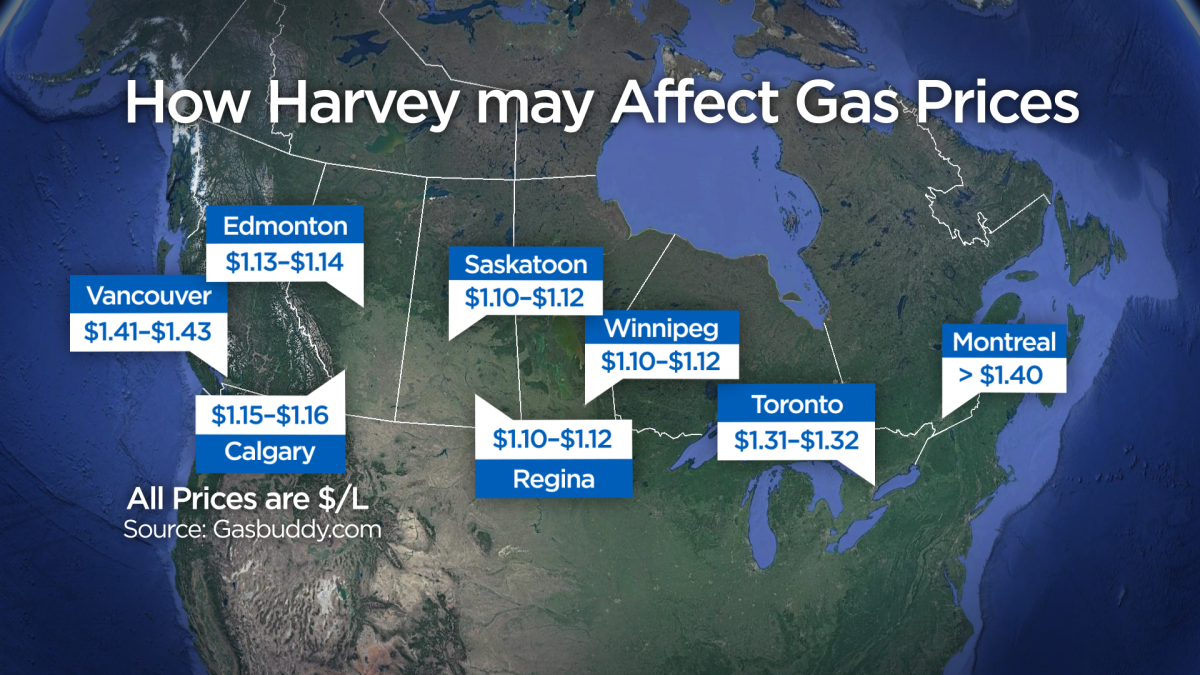Gas prices across the country are going up thanks to flooding from Hurricane Harvey, with some places set to see a jump of over nine cents per litre.

The storm, which hit Texas last Friday, has disrupted oil refineries and pipelines on the Gulf Coast, leading to higher prices in the United States – and that has bled over into Canadian pricing.
Some of the biggest pipelines in the United States, supplying the northeast market and the Chicago area, have already shut down or reduced operations because they have no fuel to pump.
WATCH: Rick Perry says more gasoline price hikes are coming

Wholesale gasoline and jet fuel prices have soared as at least 4.4 million barrels per day of refining capacity, or nearly 24 percent of total U.S. capacity, has been closed due to the record rains.
For comparison – Canada produces around 2 million barrels per day to meet its own needs, Dan McTeague, senior petroleum analyst with GasBuddy.com, said.
How it will affect Canadians, depends on where you live, McTeague explained. Toronto and Montreal could see a jump of nine cents a litre by Saturday.
“Ontario will get the brunt of it, as will Quebec, ultimately, by Wednesday next week,” McTeague explained.
“Really it’s the further you go, the less impact there is of the storm.”
He said gas retailers usually have a buffer, which is why there was a delay in the jump of prices, but by Tuesday, there will be some significant increases.
McTeague offered a look at what the country could expect in the coming week.
Atlantic Canada can also expect a jump of about 5-6 cents or more per litre, Fred Bergman, a senior policy analyst with the Atlantic Province Economic Council, told Global News earlier this week.
Anywhere west of Thunder Bay won’t see too big of an increase, because the pricing isn’t coming from the New York Harbor region, which is up 29 cents per gallon.
Prices at the pump have hit a high for the year for the United States.

Get weekly money news
“Everything from Maine all the way down to Florida, those states are most heavily affected,” McTeague said.
WATCH: Gas prices are already jumping locally
How long will we see high prices?
The prices will ultimately depend on when refineries and pipelines are up and running again.
Since the damage reports from Houston keep coming in, it could be a couple of weeks before officials have a better understanding of when production will resume to normal levels.
“We don’t even know if there’s been permanent or long-term damage to those facilities,” McTeague explained.
“So the high prices are here for the next week, and we’ll have to see after that.
“The longer it goes, the longer those prices are sustained.”
Possible gas shortage
There’s also the prospect of a gas shortage, despite the fact that there are nearly a quarter of a billion barrels of gasoline stockpiled in the United States.
But much of it is held in places where it cannot be accessed due to massive floods, or too far away from the places where it’s needed. Some of it is unfinished, meaning it needs to be blended before it can go to gas stations.
So how does that affect Canadians?
“If we keep our prices low, that shortage will morph into wholesalers driving north of the border under free trade — and picking up dozens of tankers in gasoline and that will eventually see a run in our own supplies,” McTeague explained.
WATCH: Continuing coverage of Hurricane Harvey on Globalnews.ca
*With files from Erica Alini and Reuters



























Comments